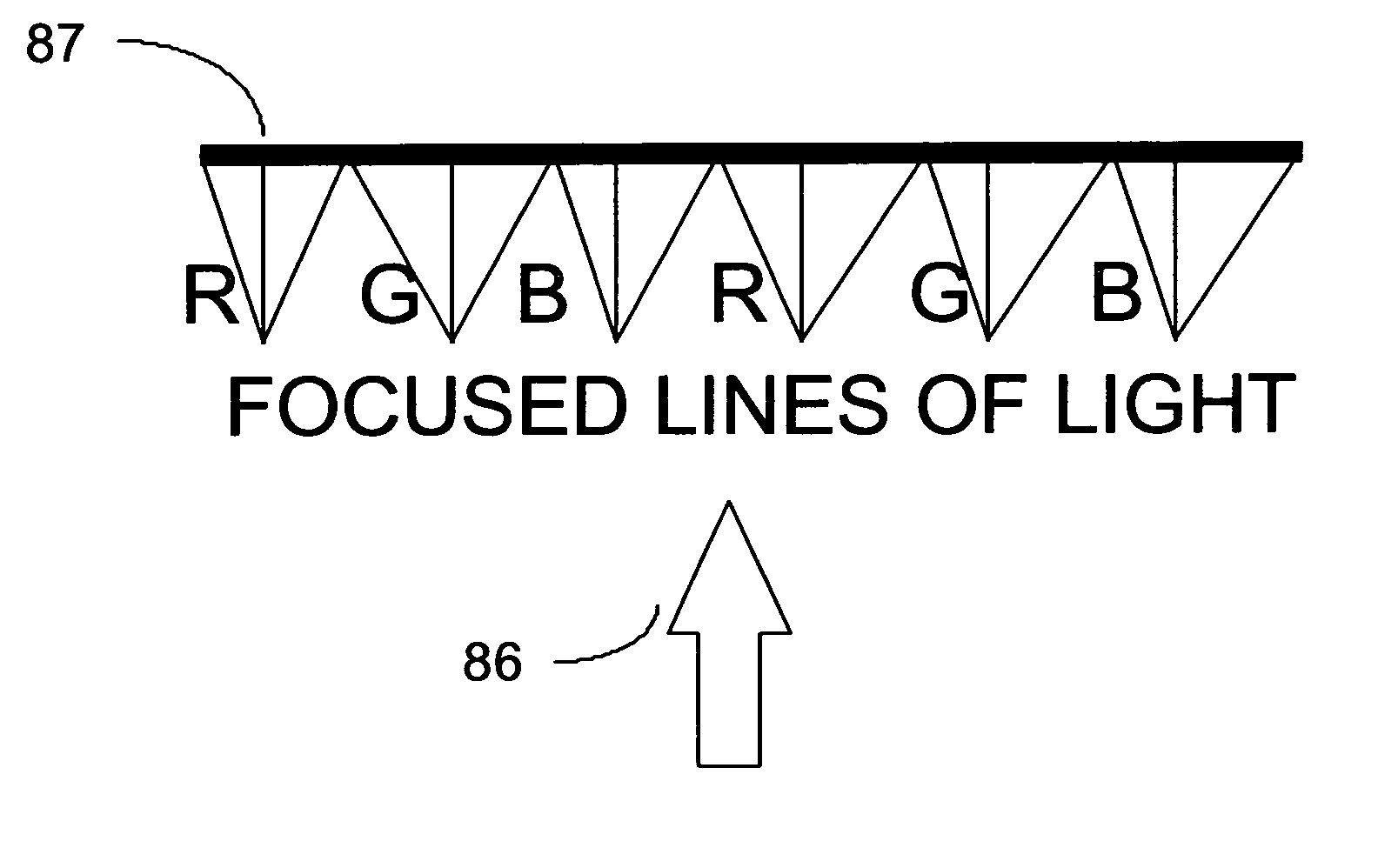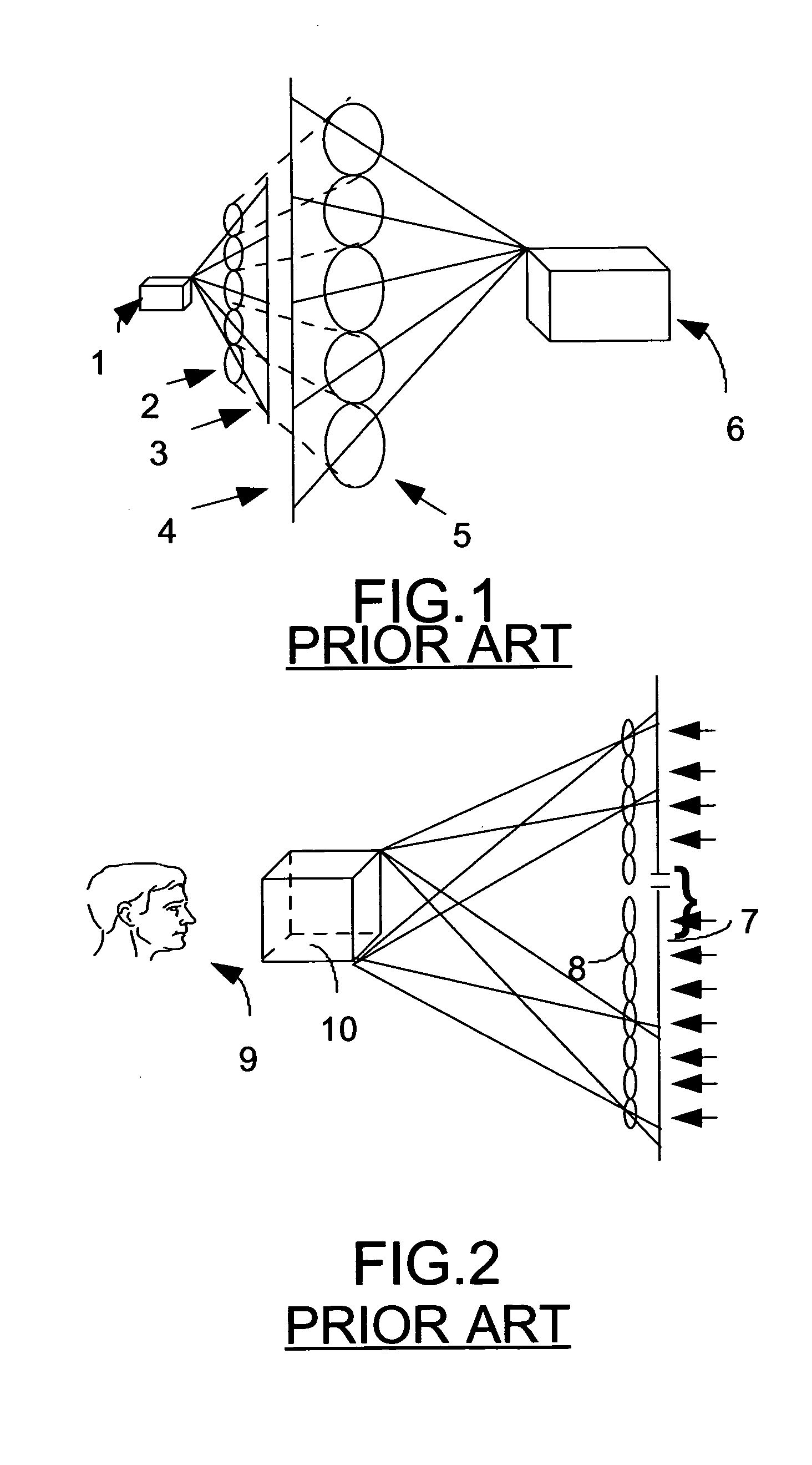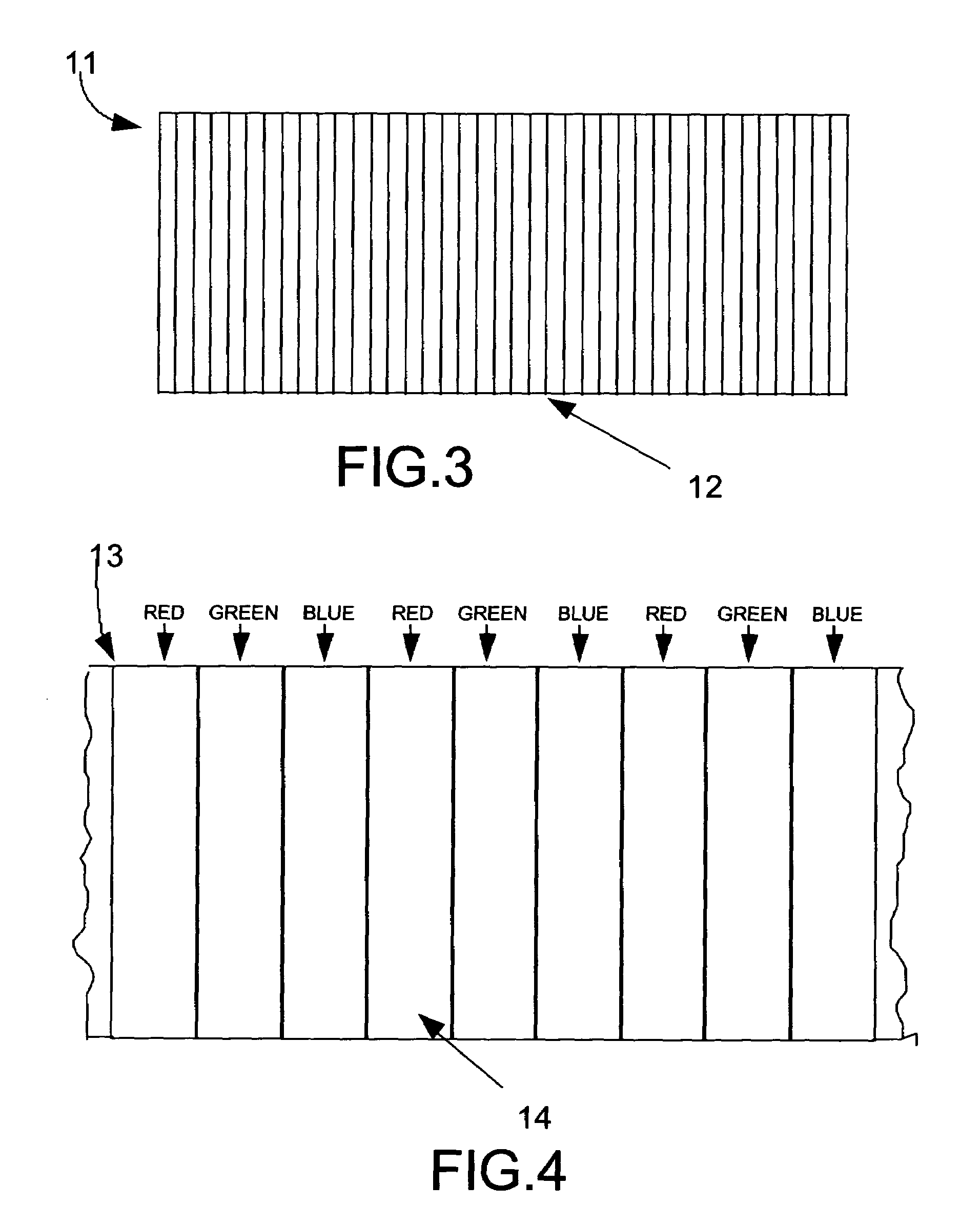Yet, the information recording and retrieval requirements for a single frame or photograph of a three-dimensional picture using the system described in the 3-D PATENTS are so great as to exceed the resolution capabilities of even this film.
The film stabilization requirements make great demands upon the projector.
Also, illumination demands are great, and very complex unmultiplexing optics are required for the projector.
Clearly, both the motion picture camera and the projector for the system disclosed in the 3-D PATENTS are much more expensive to fabricate than their current motion picture equipment counterparts.
The fact that the camera is very expensive should not discourage its use since even its higher cost would represent a small fraction of the cost of currently producing a motion picture.
History of the motion picture industry has demonstrated that special processes requiring special theaters to be built have not enjoyed enduring economic success.
However, the projector is the most expensive component in a theater designed to display these three-dimensional motion pictures.
Unfortunately, the resolution available from conventional television systems makes projection of motion pictures before large audiences in large theaters impractical.
Rear projection large screen video home entertainment systems are popular, but the video quality is much lower than with large screen conventional picture tubes.
While the quality of these pictures is acceptable to audiences attending such events, the quality of motion pictures so projected is very poor compared to the quality of conventional movies projected from film.
Some attempts have been made to digitally project popular movies in a few theaters with limited success.
The major drawback to currently available video projection systems is that the resolution is so poor compared to film projection that the audience must be seated far enough away from the screen so as not to notice the difference.
This poor image quality would probably be acceptable to viewers were film projectors not to be the motion picture display standard.
However, audiences always look for image quality improvement, and are unwilling to accept less than standard viewing conditions.
The bandwidth is simply too low.
Other transmission methods, such as fiber optic cable, have sufficient bandwidth, but the NTSC, PAL, SECAM, and even the HDTV display standards do not provide enough monitor resolution to show these movies.
However, the NTSC, PAL, or SECAM standards used therein do not adequately take advantage of the capabilities of digital video.
With many computers, the amount of information required to record an entire motion picture on the available storage media may be so large as to make such recording impractical.
Therefore, the current image formats are inadequate to meet the resolution requirements of the three-dimensional process disclosed herein.
In this case, the editors were unable to store the entire movie on their computer at one time.
Unfortunately, these also are matched to current television sets or computer monitors, and are unsuitable for use with the three-dimensional motion picture format disclosed herein.
On the other hand, generalized data compression algorithms are not necessarily keyed to photographs or video files that require display on television sets or monitors.
Unfortunately, they were confronted with bandwidth problems.
Uncompressed video at 216 Mbps and above cannot be transmitted using these methods of data delivery.
An additional problem arises when a user downloads a program from a host computer.
The problems with currently available video streaming technology are the dependence upon relatively low available bandwidths and the incapability of producing programming with acceptable resolution on commercially available computer monitors.
Even were these problems to be solved for conventional video programming, it would not be even nearly adequate for the much higher data transfer rates required for three-dimensional motion pictures produced using the process disclosed herein.
As the 3-D PATENTS' disclosure proceeded, it became apparent that, once the basic principle of magnification and projection was utilized, the primary technological problem centered around practically recording a sufficient quantity of information upon a manageable amount of photographic film.
In the Present Invention, it will become apparent that, once “the principle of magnification” is employed, the primary technological problem centers around practically recording a sufficient quantity of information on digital recording devices as well as on digitally compatible recording media.
Another major technological problem, the solution to which is addressed in the Present Invention, is integration and transmission of the vast quantity of digital information using digital electronics so as to photograph large three-dimensional scenes and to project or transmit the three-dimensional pictures produced therefrom onto a screen for viewing.
Furthermore, while broadcasting of three-dimensional photographic material over conventional television broadcast bands or even over conventional cable TV transmission is unfeasible due to bandwidth considerations, it is possible to adequately transmit such image information over closed circuit fiber optics cable.
Projection of non-stereoscopic three-dimensional motion pictures in theaters was heretofore unfeasible.
However, as will be described herein, because of image resolution problems, multiple video imaging tubes must be used.
However, when considered as a unit, this camera embodiment is not at all anticipated nor predicted by the aforementioned prior art.
The number of elemental photographs so created is insufficient to combine to produce an adequately viewable three-dimensional scene.
This is completely unusable.
Thus, using a rectangular matrix lens array for a video camera is extremely impractical.
While the vertical resolution would be excellent, the horizontal resolution would be ridiculously low.
However, the human eye would compensate for the poor horizontal resolution because there are a large number of elemental pictures positioned horizontally.
Unfortunately, the optics required to accomplish elemental picture multiplexing are complex.
While the cost of constructing a camera for this system is a factor, the camera price, even with the large number of video imaging tubes, is small when compared with the other costs incurred in motion picture production.
This method has the advantage of providing high resolution pictures, but has the disadvantage that much higher data transfer rates are required.
Video camera electronics that provide such a high transfer rate are not commercially available.
Furthermore, the electron beam scan rate of the video imaging tube is not that high.
However, a camera of this type could be too bulky to be practical.
Obviously, a single line scan image sensor cannot be used to scan all of the elemental pictures because a single sensor cannot handle all of the data required with sufficient throughput to facilitate a scan rate of 25 fps.
Each sensor can only handle a small number of elemental pictures.
Therefore, a large number of sensors must be used.
The disadvantage of such a camera lies in construction of the scanning device 37 of FIG. 10.
Such a device would be physically larger than the image sensor, and if moving parts are employed, it might tend to destabilize the camera where jitter cannot be tolerated.
In a multistage camera, were such a device to possess moving parts, there would be many such devices, and the motion could create problems.
However, both non-mechanical devices and mechanical devices that will position and scan the image onto the active surface of the sensor are currently state-of-the-art, and need not be described herein.
The disadvantage of this alternative is that a 25–50 cps vibration would be set up that could destabilize the camera.
The camera used in this process, whether film or video, is very large relative to current motion picture camera equipment.
Obviously, the camera is very heavy and must be supported and moved mechanically.
Although it is theoretically possible to compute the information required to produce the desired integral photograph using only two color video cameras, use of so few cameras does not represent the ideal embodiment.
Such a computation cannot be performed for those points appearing in one picture and not in the other.
In this situation, there will be a high degree of redundancy in all of the cameras.
However, even were the full ten mega-pixel resolution to be fully utilized, even though such a video wall would produce a reasonably high quality two-dimensional image, it would not be able to create adequate three-dimensional displays using the magnification principle.
Unfortunately, the appearance of a video wall comprised of a matrix of display devices shows boundary lines that separate the component display devices.
Some are lossy and others are lossless.
Unfortunately, LZW compression alone is not sufficient to reduce the data storage to a reasonable figure.
While this is somewhat better, it is still insufficient.
Therefore, two of the three bytes will be stored as ‘00000000’ (eight zeros), and will result in a waste of storage.
The only drawback would be vertical pixelation which would become more obvious the closer a viewer is to the screen.
Referring to FIG. 25, a twelve-bit pixel cannot exist independently since nibbles cannot be addressed directly.
This is unnecessary since the human eye is unable to differentiate so many chromatic shades.
It is not always easy to determine the image position of a given point on the video image plane.
The general pattern recognition problem in computer science has been to extract objects from a video frame and to recognize those objects.
Our problem is merely, given an image point produced from a point in space on one video frame, ascertain the location of the image point produced from the same point in space on another video frame.
Four additional problems arise.
For the fourth case, we are faced with the problem where a point that appears in one frame is obscured by an object in an adjacent frame or where a point appears at the horizontal boundary of one of the two frames.
However, we do not know how many bytes are required to store the distance information.
Yet, on a video camera CCD, one cannot resolve any points between the pixels.
This method significantly reduces the data storage requirements.
Using this method, storage requirements are minimal, but it is a very intensive computational process.
However, in this case, the frames change with time due to motion of objects in the scene.
However, it is an intense computational process.
To do this one must work with a software system, and the process requires much manual operator intervention.
Although this represents a rather arduous conversion process, current CGI and digital compositing processes used in creating special effects for current conventional motion pictures utilize much manual operator intervention.
 Login to view more
Login to view more  Login to view more
Login to view more 


